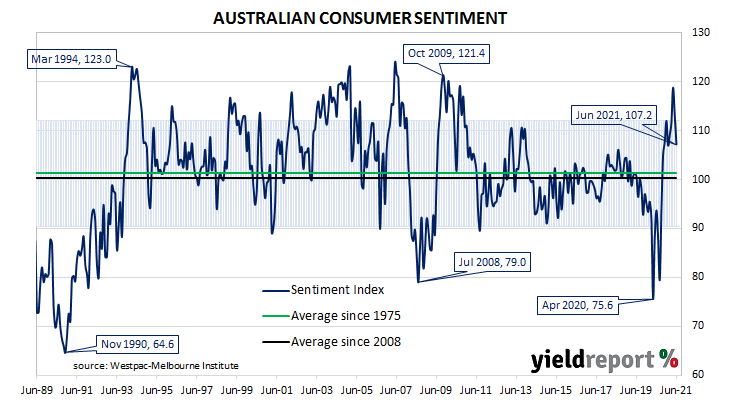Summary: Household sentiment softens in June; “almost certainly due” to Melbourne lockdown; still well above long-term average; all five sub-indices lower; unemployment index higher; falls in non-Victorian states reflects vulnerability to further outbreaks.
After a lengthy divergence between measures of consumer sentiment and business confidence in Australia which began in 2014, confidence readings of the two sectors converged again around July 2018. Both readings then deteriorated gradually in trend terms, with consumer confidence leading the way. Household sentiment fell off a cliff in April 2020 but, after a few months of to-ing and fro-ing, it then staged a full recovery.
According to the latest Westpac-Melbourne Institute survey conducted in the first week of June, household sentiment softened for a second consecutive month but remained at an above-average level. The Consumer Sentiment Index declined from May’s reading of 113.1 to 107.2.
“The latest fall in June is almost certainly due to concerns around the two-week lockdown in Melbourne. The survey was conducted during the first week of the lockdown,” said Westpac chief economist Bill Evans.
Any reading of the Consumer Sentiment Index above 100 indicates the number of consumers who are optimistic is greater than the number of consumers who are pessimistic. The latest figure is still well above the long-term average reading of just over 101.

Domestic Treasury bond yields declined on the day, largely in line with overnight movements in US Treasury bond yields. By the close of business, the 3-year ACGB yield had lost 2bps to 0.18% while 10-year and 20-year yields each finished 3bps lower at 1.52% and 2.21% respectively.
In the cash futures market, expectations of a change in the actual cash rate, currently at 0.03%, remained largely unchanged. At the end of the day, contract prices implied the cash rate would rise slowly, reaching 0.145% by October 2022.
All five sub-indices again registered lower readings; the “Economic conditions – next 12 months” sub-index experienced the largest monthly percentage decline, followed by the “Family finances versus a year ago” sub-index.
The Unemployment Expectations index, formerly a useful guide to RBA rate changes, rose from 100.2 to 108.4. Higher readings result from more respondents expecting a higher unemployment rate in the year ahead.

